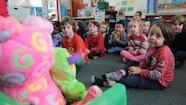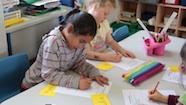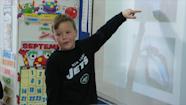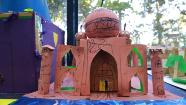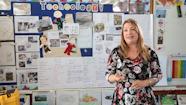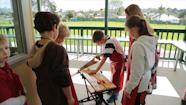By sharing a vision, these two schools have created a clear pathway for their students.
Building a shared vision between primary and secondary
Transcript
Jude Black: So I initiated our discussions with our adjacent high school because our year 7 and 8 children go there for their technology programme, and it’s a relationship that’s important to our community, that we want to continue.
The first thing I addressed with them was I shared our vision for technology education and why it’s important in our school, so that they could capture that vision and realise that it is so important to our school and I wanted to make sure our children going through to the high school were going to be able to continue that strong technology focus and potential career pathway. So that there was a vested interest in the high school making sure that their programmes were going to build on what strengths our children were going to come through with.
Gerald Lemesurier: Some of the initiatives we are working on at Green Bay High School, in the senior programme, is a lot of focus around design courses to meet the needs of the students and looking at the vocational pathways, and the career opportunities within the community of Green Bay, Titirangi and Glen Eden.
Jude Black: One of the discussions that we had was around achievement of our cohort of students and we weren't getting information about the cohort as a whole. Our board had set a strategic goal that our students would be able to achieve at level 4 of the curriculum when they finished year 8 at our school. We knew that was going to be a stretch target so I wanted to find out how were our students? Were they at that level or not? With the conversation from the high school I realised if we were using the indicators of progression, that we were probably setting our goal rather too high, and it wasn’t marrying with the way the high school saw the curriculum focus. It should have been level 3, and then when I did a bit more digging, I realised that we probably had been unduly ambitious and it was a great conversation to have with the high school.
Gerald Lemesurier: So one of the discussion points around assessment reporting with regards to discussions with Jude Black, was around how to assess students’ work, how to meet the requirements of the curriculum, you know looking at the eight areas, the components of technology, and what that would look like. Huge benefits with getting that accurate especially within the levels year 7 and 8, 8 and 9, that when they come to the high school we do not repeat any of the programmes of work that they’ve done at year 8 – so we accurately know where they are placed within the curriculum, therefore what we teach them further on in the junior school at year 9 and 10 we can actually make sure we deliver programmes that advance those students further.
Jude Black: This is an ongoing discussion and I think it’s a really valuable one, for the high school to even realise that our school values this curriculum area. It has been very productive, I’ve had discussions with the principal of Green Bay High as well, and sent her a copy of my sabbatical report, so that she is aware of the importance and can support her team to engage with us. We’re now at the stage where we’re looking at systems for reporting to parents, as well as the cohort achievement. We’re going to prepare a draft of our ideas about reporting to parents to the head of department, and for him to consider as to whether that is able to be carried out by them and they’ll probably come back with some suggestions themselves and I think that’s really beneficial to both schools.
Related videos
New entrants identify the made world (03:14)
New entrants explore what technology is with teacher Jill Harper.
Year 1–2 technologists design for a purpose (03:52)
Students in years 1 and 2 discuss with their teacher why technologists make things out of different materials.
Year 1–2 future technologists (02:06)
Kathy Chandler and her year 1–2 students discuss technological outcomes and what technologists do.
Cars are technological outcomes (03:53)
James Mawson explores cars as technological outcomes with his year 2 class.
Planning for a coherent programme in primary (02:11)
Science and technology teacher Shannon Maloney shares how she works collaboratively with teachers to integrate technology into their programmes....
Building technology inquiries in years 1–6 (02:47)
Shannon Maloney talks about building rich technology units within a programme of inquiry in years 1–6.
My role as a lead teacher technology at Green Bay Primary (02:48)
Diana Comp shares about providing resourcing, inspiration, and professional learning in her role as lead teacher technology.
Hooking primary students into technology (02:34)
Diana Comp shares some of her strategies for engaging primary students and growing understandings in technology.
Planning for technology at primary (03:59)
Jude Black and Diana Comp describe their approach to planning at Green Bay Primary.
A school-wide vision for technology teaching and spaces (03:53)
Jude Black of Green Bay Primary prompts us to consider how technology is incorporated into our school vision.

